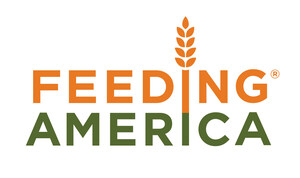Map the Meal Gap 2015 Documents Hunger in Every County and Congressional District in the Nation
Child Food Insecurity Exists In America's Most Affluent Communities
CHICAGO, April 14, 2015 /PRNewswire-USNewswire/ -- Feeding America, the nation's largest domestic hunger-relief organization, today released a new study, Map the Meal Gap 2015, which finds that food insecurity exists in every county and congressional district in the nation.
Food insecurity is the U.S. Department of Agriculture's measure of lack of access at times to enough food for an active, healthy life for all household members.
This is the fifth year the data have been compiled.
There are eight counties in the nation with median household incomes above $100,000, yet each of these counties have child food-insecurity rates above 10%. This includes four counties in Virginia: Falls Church City, Fairfax, Arlington and Loudoun. In fact, Loudoun is the wealthiest county in the U.S. with a median household income of $122,000, but is also home to more than 10,000 food-insecure children.
Other affluent counties with notable rates of child food insecurity are:
- Howard County, Maryland, where the median household income is $110,000, yet 15% of its children – more than 11,000 – are food insecure.
- Los Alamos County, New Mexico has a total population of 18,000 people with a median household income of $107,000, yet nearly 18% of its children – nearly 800 – are food insecure.
- Douglas County, Colorado has a median household income of $102,000, yet nearly 15% of its children – more than 13,000 – are food insecure.
Other key findings from the report include:
Food Insecurity at the County Level
- The county with the highest rate of food insecurity in America is Holmes County, Mississippi, where a third of the population, 33.4%, is food insecure.
- Los Angeles County is home to the largest estimated population of food-insecure people – nearly 1.5 million – a 14.7% food-insecurity rate.
- Slope County, North Dakota has the lowest rate of food insecurity of any county in the nation at 4.2%.
Food Insecurity among Children at the County Level
- Child food insecurity exists in every county where there are children, ranging from 6.2% in Billings County, North Dakota to 43% in Apache County, Arizona, home to Navaho Nation, Fort Apache and Zuni American Indian reservations.
- The largest estimated population of food-insecure children is Los Angeles County. Nearly 600,000 children, 1 in 4, live at risk of hunger.
- There are more than 400,000 food-insecure children across the five boroughs of New York City.
Race
- The report finds that hunger disproportionately affects counties where the majority of the population is black or American Indian.
- The report also finds that some of the counties with the most abundant farm lands that produce millions of pounds of fruits, vegetables and other agricultural products also have many families with children at risk of hunger. Fresno, Imperial, Kings, Merced, Monterey and Tulare counties in California all have a higher than average child food-insecurity rate and are also among the top 10 agricultural producers. All six counties have a majority Latino population.
Local Meal Cost and Food Budget Shortfall
- In addition to rates of food insecurity, Map the Meal Gap 2015 estimates the relative cost of an average meal by county.
- The lowest meal cost is $1.97 in Maverick County, Texas.
- The highest meal cost is $5.01 in Crook County, Oregon.
- The meal-cost data demonstrates that 26.4 million food-insecure people live in areas where food costs are higher than the national average.
- The food price data and analysis was provided by Nielsen (NYSE: NLSN), a global provider of information and insights.
- The report estimates that food-insecure American households have a total "food budget shortfall" of $24.2 billion, compared to $23.5 billion in last year's report, an increase of $700 million.
Food Insecurity at the Congressional District Level
Highest Rates
| District |
Food Insecurity Rate (2013) |
# of Food Insecure Persons (2013) |
Child Food Insecurity Rate (2013) |
# of Food Insecure Children (2013) |
| Congressional District 13, Michigan |
29.3% |
197,340 |
30.5% |
50,890 |
| Congressional District 2, Mississippi |
28.7% |
208,530 |
32.5% |
60,490 |
| Congressional District 11, Ohio |
28.1% |
194,480 |
30.3% |
46,770 |
| Congressional District 5, Florida |
27.4% |
199,970 |
31.6% |
58,270 |
| Congressional District 9, Tennessee |
26.9% |
191,540 |
29.2% |
52,900 |
| Congressional District 7, Alabama |
26.6% |
177,700 |
29.1% |
43,240 |
| Congressional District 14, Michigan |
26.5% |
187,000 |
26.0% |
42,480 |
| Congressional District 2, Pennsylvania |
26.3% |
187,150 |
24.4% |
34,930 |
| Congressional District 12, North Carolina |
26.2% |
202,960 |
30.5% |
60,180 |
| Congressional District 1, North Carolina |
26.1% |
188,920 |
30.2% |
50,480 |
Lowest Rates
| District |
Food Insecurity Rate (2013) |
# of Food Insecure Persons (2013) |
Child Food Insecurity Rate (2013) |
# of Food Insecure Children (2013) |
| Congressional District 10, Virginia |
6.0% |
47,080 |
12.0% |
26,010 |
| Congressional District 3, New York |
6.8% |
49,590 |
14.7% |
24,070 |
| Congressional District 2, New York |
6.9% |
49,430 |
14.8% |
23,610 |
| Congressional District 1, New York |
7.4% |
53,270 |
16.2% |
25,710 |
| Congressional District 11, Virginia |
7.4% |
56,590 |
12.7% |
23,120 |
| Congressional District 7, New Jersey |
7.6% |
56,570 |
12.8% |
22,570 |
| Congressional District (at Large), North Dakota |
7.8% |
56,430 |
10.4% |
16,780 |
| Congressional District 6, Illinois |
7.9% |
57,760 |
15.4% |
27,700 |
| Congressional District 8, Maryland |
7.9% |
59,350 |
16.9% |
29,120 |
| Congressional District 4, New York |
8.2% |
58,570 |
15.7% |
25,070 |
Map the Meal Gap 2015 is based on an analysis of statistics collected by the U.S. Department of Agriculture, U.S. Census Bureau, and the U.S. Bureau of Labor Statistics in 2013, the most recent year for which data is available.
The study is supported by the founding sponsor The Howard G. Buffett Foundation as well as the ConAgra Foods Foundation and Nielsen. The lead researcher is Dr. Craig Gundersen, professor of Agricultural and Consumer Economics at the University of Illinois, executive director of the National Soybean Research Laboratory and member of Feeding America's Technical Advisory Group.
"Feeding America will provide food and groceries to more than 46 million Americans this year who are living on the brink of hunger," said Bob Aiken, CEO of Feeding America. "Map the Meal Gap 2015 provides unique insight into the prevalence of food insecurity in each county and congressional district in our nation. It will help policy makers and our elected officials understand the challenges they face in addressing hunger in the communities they serve."
"We must shine a light on the hidden hunger crisis in America if we want to make our nation stronger and create a brighter future for everyone," said Howard G. Buffett, Chairman and CEO of The Howard G. Buffett Foundation and founding sponsor of Map the Meal Gap. "This data is a powerful tool that we hope will educate people about hunger in their own communities, and more importantly, compel all of us to work to address the issue."
"Our Foundation funded Map the Meal Gap because all Americans, especially policymakers, need to realize that hunger is a serious problem in our country—one that directly impacts our future prosperity," Buffett continued. "These statistics demonstrate the need for strong hunger-relief programs like Feeding America. Longer-term, we need more permanent solutions that improve the economic opportunities available to people who are prone to food insecurity."
Map the Meal Gap 2015 provides the following data for each county in the United States in an interactive map format:
- The percentage of the population who is food insecure.
- The percentage of the food-insecure population who likely qualify based on income for SNAP (formerly the Food Stamp Program) and other federal nutrition programs.
- The percentage of the food-insecure population who likely do NOT qualify for federal nutrition programs and often must rely on charitable food assistance programs. These are households reporting earnings higher than the federal programs income eligibility limits.
- The average price per meal in each county.
A summary of the findings, an interactive map of the United States, and the full report are available at map.feedingamerica.org.
Join the conversation about Map the Meal Gap 2015 on Twitter using #MealGap.
About Feeding America
Feeding America is the nationwide network of 200 food banks that leads the fight against hunger in the United States. Together, we provide food to more than 46 million people through 60,000 food pantries and meal programs in communities across America. Feeding America also supports programs that improve food security among the people we serve; educates the public about the problem of hunger; and advocates for legislation that protects people from going hungry. Individuals, charities, businesses and government all have a role in ending hunger. Donate. Volunteer. Advocate. Educate. Together we can solve hunger. Visit www.feedingamerica.org, find us on Facebook or follow us on Twitter.
For further information or to arrange interviews, please contact:
Ross Fraser
312.641.6422
[email protected]
SOURCE Feeding America
Related Links
WANT YOUR COMPANY'S NEWS FEATURED ON PRNEWSWIRE.COM?
Newsrooms &
Influencers
Digital Media
Outlets
Journalists
Opted In





Share this article